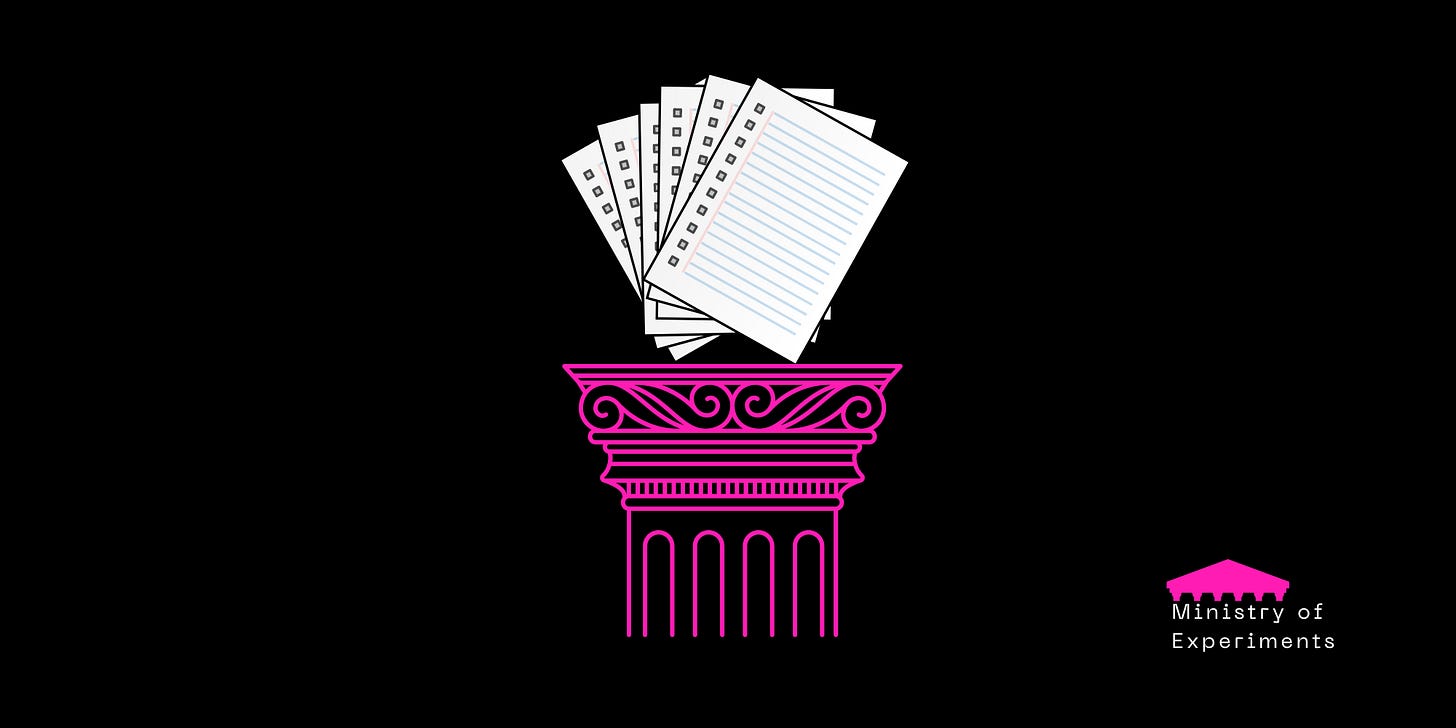Ode to Doc Reads
In praise of the silent and synchronous review of plain and concise prose, leading to wise and deliberate decisions.
Sing, oh Muse, of the wisdom grand, Hidden in plain sight in a six-page land. A fortress of simple prose towering still Over a web of confused threads that make decisions ill. No slides to hide behind, no bullet's brief escape, But narratives that sculpt the future's shape. No illusion of design, no hurried speech, When unassailable facts keep sophistry out of reach. Sirens and slogans suffer great defeat When Doc Reads hold Ulysses steady in his seat. Silence falls and calm surrounds the space, while reading minds regain their essential grace. As dancing pens search truth in every numbered line, The author readies the answers she can divine. When the hourglass expires and gazes turn to face, Duelling questions begin to show which choice to embrace. Consider what you came to find: Not charming shouts or shiny titles to make you blind, But sound bastions to help your realm grow, Even built by those who are shy and don’t seem to glow. Oh Doc Read, glorious compass for truth-seeking strides, Lost ritual in a Babylon of tweets, messages, and likes! May the Muse inspire more of us to write To preserve Your stronghold of clear thought in times of narrative blight.
Notes on Doc Reads
What is a Doc Read?
A Doc Read is a mechanism for decision-making born at Amazon. It consists of the review of a “narrative” or “doc”, which is at most six pages long - excluding appendices.
The doc is presented by the owner at the time of the Doc Read. This means that reviewers require no previous preparation. When the Doc Read begins, participants read the narrative in silence for the required time, generally between 15-30 minutes. When readers have finished the review, they discuss the document from general to specific feedback. The owner of the doc is responsible for integrating the feedback and taking the next steps.
Benefits of Doc Reads
I enjoyed first hand the benefits of this practice, during my time at Amazon Web Services. Its power is even more evident now that I no longer work there and interact with a variety of other decision-making models. In my experience, the primary benefits of Doc Reads are:
Clear writing = clear thinking. Writing forces the organisation of thoughts into logical and coherent structure. Gaps in critical thinking or data are easier spotted on the page. Writing puts the onus of clarity on the author, while PowerPoints put the responsibility to understand on the audience. In addition, PowerPoints incentivise the presenter to impress. This often leads to over-simplifying complexity.
Aligned understanding. Peer-reviewing the same document at the same time minimises misunderstanding. As a result, participants in a Doc Read will be more likely to be highly aligned to what they are committing to. This allows teams to operate the next steps with speed and autonomy, without second-guessing.
Collective attention. Reading the same document at the same time, possibly in the same room, generates peer pressure to concentrate. This is especially valuable in our times of fragmented attention and communication tools.
Substance > charisma. It’s harder to hide behind black ink on a white page, than behind a fancy-looking slide with sensational title and buzzing bullets. What’s more, writing levels the playing field for introverts, who might be full of wisdom but uncomfortable to present it on a stage.
Here’s more about what I learnt at Amazon that I wish I knew before.
Caution ⚠️
Like any other device, Doc Reads can be instrumentalised or bureaucratised.
Beware of:
Sabotage by committee. From the CIA Sabotage Field Manual from 1944: "Refer all matters to committees for further study. Attempt to make the committees as large as possible." Doc Reads should not become like Penelope’s endless weaving and unweaving of a canvas.
Fetishising docs. Not every decision is complex enough in terms of content and number of stakeholders to deserve a full 6-page narrative. 1-pagers can be effective decision-making devices. Document types should tailor to the size, scope, and consequentiality of a decision.
Not all writing is created equal. Writing great docs is hard work; it’s both science and art. It takes more than formatting bullets into Word. It also takes more than asking ChatGPT - even though co-intelligence can help, as
writes. If you want to to learn more about how to write the Amazon way, check out by .
Do You Know Better?
I would love to learn from you:
What decision-making practices have you found most effective?
Please share your experiences and examples in the comments, to make the MoX community better at decision-making.




Excellent post Leo!! I also miss doc reads, I wish more organizations would see its benefits. That said, this post also reminded to something someone told me after I left AWS: "you can take people out of Amazon, but you can't take Amazon out of people" ... is there some truth in that? ;-)
Great prose, great idea.
I like the constructive respect of joint silent reading. The so-called tutorial method is somehow in counterpoint: everyone has been thinking and researching the issue, one person reads aloud their doc.
The need to develop a culture of professional writing is very important and a lost art. In my own early days in public service, very senior people sat me down and dismantled and rebuilt my early efforts. Something stuck.